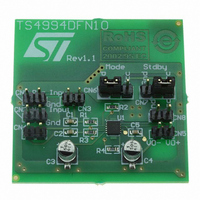STEVAL-CCA002V1 STMicroelectronics, STEVAL-CCA002V1 Datasheet - Page 21

STEVAL-CCA002V1
Manufacturer Part Number
STEVAL-CCA002V1
Description
BOARD EVAL FOR LP DIFF TS4994IQT
Manufacturer
STMicroelectronics
Specifications of STEVAL-CCA002V1
Design Resources
STEVAL-CCA002V1 Gerber Files
Amplifier Type
Class AB
Output Type
1-Channel (Mono)
Max Output Power X Channels @ Load
1W x 1 @ 8 Ohm
Voltage - Supply
2.5 V ~ 5.5 V
Operating Temperature
-40°C ~ 85°C
Board Type
Fully Populated
Utilized Ic / Part
TS4994
Description/function
Audio Amplifiers
Operating Supply Voltage
2.5 V to 5.5 V
Output Power
1 W
Product
Audio Modules
Silicon Manufacturer
ST Micro
Silicon Core Number
TS4994
Kit Application Type
Amplifier
Application Sub Type
Audio Power Amplifier
Kit Contents
Board
Rohs Compliant
Yes
Lead Free Status / RoHS Status
Lead free / RoHS Compliant
For Use With/related Products
TS4994
Other names
497-6395
STEVAL-CCA002V1
STEVAL-CCA002V1
TS4994
4
4.1
4.2
Note:
4.3
Application information
Differential configuration principle
The TS4994 is a monolithic full-differential input/output power amplifier. The TS4994 also
includes a common mode feedback loop that controls the output bias value to average it at
V
maximum output voltage swing, and by consequence, maximize the output power.
Moreover, as the load is connected differentially, compared to a single-ended topology, the
output is four times higher for the same power supply voltage.
The advantages of a full-differential amplifier are:
●
●
●
●
●
●
The main disadvantage is:
●
Gain in typical application schematic
Typical differential applications are shown in
In the flat region of the frequency-response curve (no C
expressed by the relation:
where R
For the rest of this section, Av
Common mode feedback loop limitations
As explained previously, the common mode feedback loop allows the output DC bias voltage
to be averaged at V
However, due to V
mode feedback loop can play its role only within a defined range. This range depends upon
CC
/2 for any DC common mode input voltage. This allows the device to always have a
Very high PSRR (power supply rejection ratio).
High common mode noise rejection.
Virtually zero pop without additional circuitry, giving a faster start-up time compared
with conventional single-ended input amplifiers.
Easier interfacing with differential output audio DAC.
No input coupling capacitors required due to common mode feedback loop.
In theory, the filtering of the internal bias by an external bypass capacitor is not
necessary. But, to reach maximum performance in all tolerance situations, it is better to
keep this option.
As the differential function is directly linked to the mismatch between external resistors,
paying particular attention to this mismatch is mandatory in order to get the best
performance from the amplifier.
in
= R
in1
= R
ICM
CC
in2
limitation of the input stage (see
/2 for any DC common mode bias input voltage.
and R
A
feed
diff
V
diff
will be called A
=
= R
----------------------------------------------------- -
Diff
feed1
input+
V
O+
= R
Figure 1
–
–
feed2
Diff
V
V
O
to simplify the expression.
input-
.
and
Table 3 on page
in
=
effect), the differential gain is
R
------------- -
Figure 2 on page
R
feed
in
Application information
6), the common
4.
21/35





















